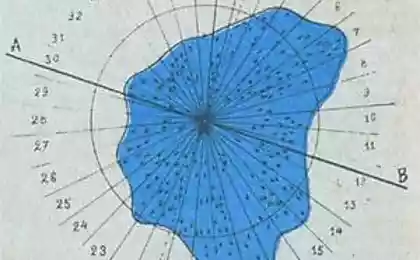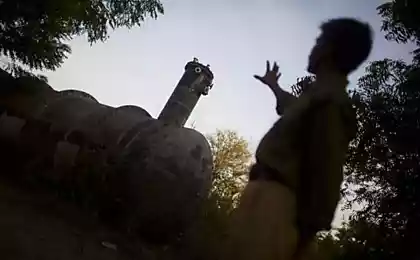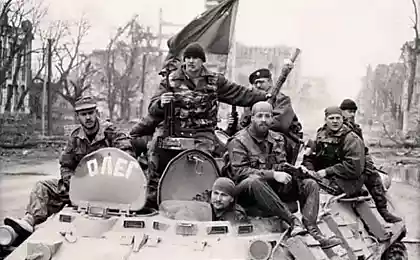2415
Major rail accident in the USSR
1. Ufa train disaster
Date: 3 (4) June 1989
Killed: 575
Injured: 623
The largest in the history of Russia and the USSR railway accident that occurred June 4 (June 3 Moscow time) in 1989 in Bashkiria iglinsky district, 11 km from the town of Asha (Chelyabinsk region) on the stretch Asha - Ulu Telyak. At the time of the passage of two oncoming passenger train № 211 "Novosibirsk - Adler" and the number 212, "Adler - Novosibirsk" there was a powerful explosion clouds of light hydrocarbons formed as a result of the accident in passing near the pipeline "Siberia - Ural - Volga region". Killed 575 people (according to other sources 645), 181 of them - children, injured more than 600.
Will be 25 photos + text

June 4, 1989 at 01:15 local time (June 3 at 23:15 Moscow time) at the meeting of the two passenger trains thundered powerful gas and dust explosion flashed a giant fire.
The train number 211 "Novosibirsk - Adler" (20 wagons, locomotive VL10-901) and number 212 "Adler - Novosibirsk" (18 wagons, locomotive CHS2-689) was a passenger in 1284 (including 383 children) and 86 members of train and locomotive crews. Shock waves from the track was cleared 11 cars, 7 of them completely burnt. The remaining 27 cars were burned on the outside and burned inside. According to official figures 575 people were killed (according to other sources - 645); 623 became disabled, suffered serious burns and injuries. Children among the dead - 181.
The explosion of a large volume of gas distributed in space, had the character of dust explosion. The power of the explosion was estimated at 250-300 tons of TNT. According to other estimates, the power of dust explosion can reach up to 12 kilotons of TNT, which is comparable with the power of a nuclear explosion in Hiroshima (16 kilotons). There are allegations that the explosion has triggered the alarm system of air defense of the North American continent (NORAD).
The power of the explosion was such that the shock wave blew out windows in the city of Ash, located more than 10 km away from the scene. A pillar of flame was seen more than 100 km. It destroyed 350 meters of railway tracks, 17 km of overhead lines. Emerged in the explosion of a fire engulfed an area of approximately 250 hectares.

The official version says that the leakage of gas from the product pipeline is made possible because of the damage inflicted by his excavator bucket during its construction in October 1985, four years before the crash. The leak began 40 minutes before the explosion.
In another version of the cause of the accident was corrosive to the outer part pipes electrical leakage currents, so-called "ground currents" railroad. 2-3 weeks before the explosion formed mikrosvisch, then, as a result of the cooling tubes in place of gas expansion appeared to grow long crack. The liquid condensate infiltrated the soil to a depth of the trench, do not go outside, and gradually descended down the slope to the railway.
At a meeting of two trains, possibly as a result of braking, there was a spark that caused the detonation gas. But the most likely cause was an accidental detonation of the gas spark from the pantograph of a locomotive.
There is a conspiracy theory that the accident is supposedly one of the many man-made disasters in the last years of the Soviet Union, relating to the activities of US intelligence, which has been tasked to maximize destabilize the Soviet Union. The rationale is the book by Thomas Reed - the former Commander of the US Air Force, which was part of the Reagan of the US National Security Council. It describes the operation of the CIA on the explosion of a gas pipeline to the Soviet Union in 1982, however, there are no arguments in favor of the fact that an explosion of the gas pipeline near Ufa involved in special services of foreign states, the book does not contain.

Six years went on trial, was charged with nine officers, two of whom were subject to the amnesty. Among others - Head of Construction Management of trust "Nefteprovodmontazh" superintendents, other specific performers. The charges were presented under Article 215 Part II of the Criminal Code of the RSFSR. The maximum penalty - five years in prison.
Association was established and relatives of the victims affected by Ashoy.
In 1992 on the site of the tragedy it was erected a memorial to the eight-meter. Every year at the monument to victims of the disaster are mourning rallies.
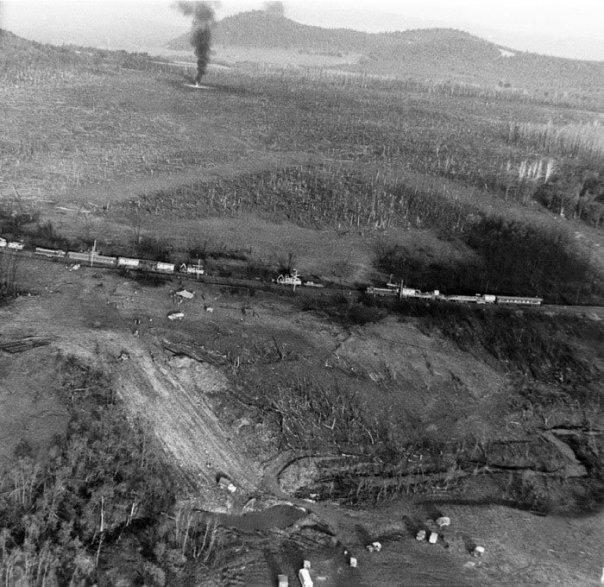
2. The collapse of the station Kamenskaya
Date: August 7, 1987
Killed: 106
Injured: 114
The tragedy occurred on the night August 7th, 1987 at Likhovsky department South Eastern Railway in the city of Kamensk-. Heavy freight train due to failure of the brake due to the fault of railway workers failed to brake on a steep slope, and speeding up considerable speed, entered the station Kamensky. When you follow the structure of the station to disengage into several parts. When this department locomotive with one carriage drove a few hundred meters and collided with the tail of a passenger train standing at the time the platform. As a result of the disaster freight train and a few passenger cars were damaged to the extent exclusion from the inventory, killing 106 and wounding 114 people, a complete interruption of traffic in the area was 88 hours and 15 minutes.

Kogda uncontrollable freight train was approaching the station, the driver ordered his assistant to leave the cab. Before leaving, the assistant driver lets go of the microphone, allowing DSP finally communicates with the engineer of the train number 335, and a brief explanation of the criticality of the situation, ordered that a yellow traffic signal N5 (output from the 5th way) to go from the station. However, the conductors of wagons were not aware of what is happening, so when just a minute after standing at the platform passenger train started to go, the car number 10 wire Turkin G. pulled the emergency brake. This was done according to the job description, to stop suddenly and make travel by train properly landing passengers. Assistant driver passenger electric Panteleiciuc ran to this car, to explain the situation, but the time was not. At 01:31 the station Kamenskaya at about 140 km / h driven freight train № 2035. The train proceeded to the turnout number 17, where by following in the branch there was a gap between the first coupler and the second carriage, followed by a second train derailment, and flown to him the other cars to form a blockage. However, electric, with one carriage - grain weight of 288 tons remained on the tracks and followed on the 5th path where traveled 464 meters and at speeds exceeding 100 km / h collided with the tail of a passenger train, destroying cars with sleeping people.

The accused were considered Dagestan Scientific Center, and particleboard plant Kamensky, who are not prepared for a runaway train safe route osmotrschiki wagons, which checked the brakes of the train number 2035 with gross violations, the locomotive crew of the train, which is not supervised work osmotrschikov wagons and locomotive crew of the train number 335 not promptly remove the passenger train, and the train conductor 10. However, during the investigation of the CPD and the Dagestan Scientific Center were justified because their actions prevented the safety interlock shooter, was acquitted and locomotive crews train number 335 and the conductor, as they were not aware of the danger. In addition, humanitarian reasons, it was decided not to judge and locomotive crews train number 2035: assistant engineer was severely crippled, and the driver and all became disabled. As a result, the dock fell osmotrschiki cars Trusov and Puzanov NV November 17, 1988 TASS transmits a message according to which these workers were sentenced to 12 years.
In addition, it was removed from the post of the chief of the South-Eastern Railway Goliusov A. and Likhovsky office was transferred from the Southeast to the North Caucasus Railway.
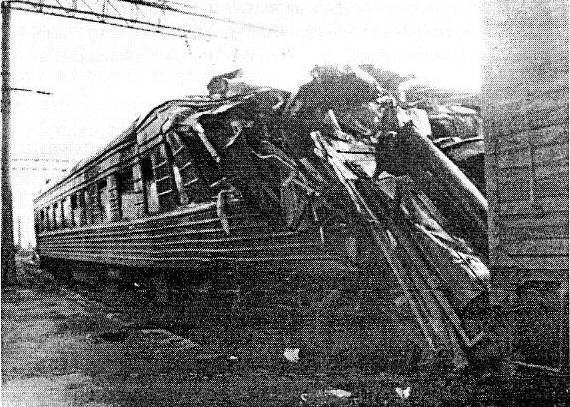
3. Arzamas train disaster
Date: June 4, 1988
Killed: 91
Injured: 799
June 4, 1988 at 09:32 train, which contained 3 car with 120 tons of explosives intended for the mining and other enterprises, followed by the railway crossing in the town of Arzamas, located in the northern neck of the station Arzamas I. In this moment (9 32) there was an explosion. Among detonated explosives were:
30 tons of TNT blocks,
charges for oil,
25 tons ammonal,
5 tons of ammonite,
30 tons of RDX,
27 tons of HMX, and others.

The power of the explosion was such that on the ground remains a funnel depth of 26 meters, and a section "B" of the locomotive 2TE10M-0405 has been abandoned for 200 meters. The blast destroyed 151 house 823 families were left homeless. According to official statistics killed 91 people, injured 1,500 people. It destroyed 250 meters of track, the railway station is damaged, destroyed power substation, power lines, damaged gas pipeline. Injured 2 hospitals, 49 kindergartens, 14 schools and 69 shops. The basic version of the explosion found a violation of the rules of loading and transportation of explosives, but as one of the versions considered and act of terrorism and sabotage on the part of the security services of other countries in order to discharge instability in the Soviet Union.
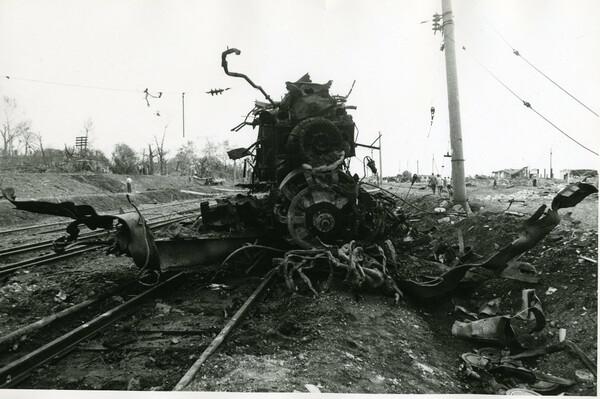
In Arzamas at the blast site to build a chapel and memorial, which bears the names of the dead. Every year on June 4, the city hosts the mourning events dedicated to the memory of those killed in the blast.

4. The collapse of the station Koristovka
Date: November 6, 1986
Killed: 44
Injured: 100
November 6, 1986 at 3 o'clock 02 minutes Moscow time on station Koristovka (Kirovohrad region) Odessa railway crashed passenger train number 635 Krivoy Rog - Kiev running driver Galuschenko and assistant driver Szyszko (Roundhouse Taras Shevchenko) and number 38 Kiev - Donetsk running Lazarenko driver and assistant driver Shastun (Roundhouse Taras Shevchenko) with severe consequences.

Machinist Galuschenko (train number 635) has transferred control of the locomotive driver assistant Szyszko and during the arrival of the train at the station Koristovka action it did not control, was asleep on duty. Assistant driver after prosledovaniya entrance traffic light with two yellow lights when driving on the site, are not equipped with devices of travel automatic locomotive signaling, reduced speed of up to 30, 7 km / h, and then lost vigilance. Locomotive staff continue to not respond to the call and the person on duty at the station by radio and did not take steps to stop the train before routing the traffic lights to prohibiting signal, allowed his travel, incision of the arrow and collided with the train number 38, follow the second path, the station without stopping.

As a result of the collapse of the exceptions to the extent of inventory damaged locomotives of both trains - locomotives CHS4 number 005 and 071, broken several passenger cars. 44 people were killed. 100 people were wounded, 27 of them seriously.

5. Crash station Podsosenka
Date: March 3, 1992
Killed: 43
Injured: 108
March 3, 1992 5 hours and 15 minutes at the junction Podsosenka single-track section of Great Luke - Rzhev Rzhev branch of the October railway crashed with grave consequences express train number 4 posts Riga - Moscow en route under the control of the driver Depot Great Luke Leningrad-Vitebsk branch road Morozova GT and the assistant driver Efimova OV and a freight train number 3455 opposite direction under the control of the driver depot Rzhev.
It was found that the fast passenger train number 4 followed the earlier schedule for 3 minutes and was taken to the main road junction on an open fire on a yellow traffic light input to stop for crossing with freight train arriving.

Following to the station, the driver of the passenger train on the radio calls not answered. The Commission noted later use of automatic brakes in front of the train output CH1 with red fire, which led to its passage, and a collision with an oncoming freight train locomotive number 3455 at the direction № 1. Locomotive staff passenger train was at work 4 hours had sufficient rest and the home grounds for distraction from observing the signals had. The collision caused a fire in locomotives that has spread to passenger cars.

The collision killed two train locomotive crews, the conductor of the second carriage of a passenger train and 36 passengers injured 22 people, divided into 4 sections locomotives, 8 cars of a freight train and a passenger train 4, destroyed one of switches and 23 meters way. Approved break the movement of trains in the area 15 hours and 30 minutes.

6. The crash on the stretch Berezayka - Poplavenets
Date: August 16, 1988
Killed: 31
Injured: more than 100
August 16, 1988 at 18:25 Moscow time on the stretch Berezayka - Poplavenets Bologovsky branch of the October railway on 307-308 km of highway crashed high-speed passenger train № 159 "Aurora", driven by electric CHS6-017.
Status way to 306-308 km of continuously deteriorated in the period before the crash. The day before the crash at check-wagon track geometry car were installed retreat in the content path in the 306-308 km of the IV and V degrees on the drawdown of distortions, on the situation in terms of the way. Such deviations do not ensure the safety of traffic with the set speed of 160 km / h in accordance with the technical guidance required speed limit on the 306 th kilometer to 60 km / h at 307 th - up to 120 km / h and 308 th - up 25 km / h.
Drawdown path was so big that led to samorastsepu the first car and the locomotive of the train number 159, follow this kilometers at a speed of 155 km / h. The difference in height at the time of pulling faces samorastsepa was so large that the automatic coupling electric CHS6-017 train number 159 from the first car was damaged supporting beam, which supports the transition area.

As a result, there was samorastsepa broken brake line that caused the emergency braking of the train composition. At the same time there was an additional longitudinal force, which led to the destruction of an attenuated way at the end of the first picket of 308 km and immediately followed by the collapse of the wagons.
High-speed passenger train route was due to the fact that the senior master traffic unreasonably, without troubleshooting canceled the warning by which the rate of repetition was limited to 60 km / h. This warning was issued by the deputy chief of puteizmeritelnogo car and could be canceled in accordance with paragraph. 7.14 Instructions to ensure traffic safety in the production of travel papers (CP / 4402), only the head of the path distance.
In the dining car as a result of tipping caused a fire that spread to the other carriages. Fire trucks, hurrying out of Bologoye, Vishny Volochek, Udomlya and Borovichi, failed to promptly get to the place because of the swampy terrain. Fire Train, released to the crash site quickly exhausted supplies of water because of the large-scale fire. For the delivery of water to extinguish the fire was organized by the constant running of fire trucks from the water source, located about 2 kilometers from the accident site to the nearest place to which it was possible to drive. This place was about 150-200 meters away from the railway line, then the solid was marshy area where the water depth reaches 50-60 cm in some places. Fire and arrived to the crash site conscripts did pass on this section of the felled trees and paved hose lines to supply water for fire fighting.

All 15 cars of a passenger train derailed. Damaged catenary 2500m, 500m railway. To the extent exclusion from the inventory damaged 12 cars.
As a result, 31 people died and over 100 received injuries of varying severity, an interruption in the movement of trains in the area for more than 15 hours.

Source:
Date: 3 (4) June 1989
Killed: 575
Injured: 623
The largest in the history of Russia and the USSR railway accident that occurred June 4 (June 3 Moscow time) in 1989 in Bashkiria iglinsky district, 11 km from the town of Asha (Chelyabinsk region) on the stretch Asha - Ulu Telyak. At the time of the passage of two oncoming passenger train № 211 "Novosibirsk - Adler" and the number 212, "Adler - Novosibirsk" there was a powerful explosion clouds of light hydrocarbons formed as a result of the accident in passing near the pipeline "Siberia - Ural - Volga region". Killed 575 people (according to other sources 645), 181 of them - children, injured more than 600.
Will be 25 photos + text

June 4, 1989 at 01:15 local time (June 3 at 23:15 Moscow time) at the meeting of the two passenger trains thundered powerful gas and dust explosion flashed a giant fire.
The train number 211 "Novosibirsk - Adler" (20 wagons, locomotive VL10-901) and number 212 "Adler - Novosibirsk" (18 wagons, locomotive CHS2-689) was a passenger in 1284 (including 383 children) and 86 members of train and locomotive crews. Shock waves from the track was cleared 11 cars, 7 of them completely burnt. The remaining 27 cars were burned on the outside and burned inside. According to official figures 575 people were killed (according to other sources - 645); 623 became disabled, suffered serious burns and injuries. Children among the dead - 181.
The explosion of a large volume of gas distributed in space, had the character of dust explosion. The power of the explosion was estimated at 250-300 tons of TNT. According to other estimates, the power of dust explosion can reach up to 12 kilotons of TNT, which is comparable with the power of a nuclear explosion in Hiroshima (16 kilotons). There are allegations that the explosion has triggered the alarm system of air defense of the North American continent (NORAD).
The power of the explosion was such that the shock wave blew out windows in the city of Ash, located more than 10 km away from the scene. A pillar of flame was seen more than 100 km. It destroyed 350 meters of railway tracks, 17 km of overhead lines. Emerged in the explosion of a fire engulfed an area of approximately 250 hectares.

The official version says that the leakage of gas from the product pipeline is made possible because of the damage inflicted by his excavator bucket during its construction in October 1985, four years before the crash. The leak began 40 minutes before the explosion.
In another version of the cause of the accident was corrosive to the outer part pipes electrical leakage currents, so-called "ground currents" railroad. 2-3 weeks before the explosion formed mikrosvisch, then, as a result of the cooling tubes in place of gas expansion appeared to grow long crack. The liquid condensate infiltrated the soil to a depth of the trench, do not go outside, and gradually descended down the slope to the railway.
At a meeting of two trains, possibly as a result of braking, there was a spark that caused the detonation gas. But the most likely cause was an accidental detonation of the gas spark from the pantograph of a locomotive.
There is a conspiracy theory that the accident is supposedly one of the many man-made disasters in the last years of the Soviet Union, relating to the activities of US intelligence, which has been tasked to maximize destabilize the Soviet Union. The rationale is the book by Thomas Reed - the former Commander of the US Air Force, which was part of the Reagan of the US National Security Council. It describes the operation of the CIA on the explosion of a gas pipeline to the Soviet Union in 1982, however, there are no arguments in favor of the fact that an explosion of the gas pipeline near Ufa involved in special services of foreign states, the book does not contain.

Six years went on trial, was charged with nine officers, two of whom were subject to the amnesty. Among others - Head of Construction Management of trust "Nefteprovodmontazh" superintendents, other specific performers. The charges were presented under Article 215 Part II of the Criminal Code of the RSFSR. The maximum penalty - five years in prison.
Association was established and relatives of the victims affected by Ashoy.
In 1992 on the site of the tragedy it was erected a memorial to the eight-meter. Every year at the monument to victims of the disaster are mourning rallies.

2. The collapse of the station Kamenskaya
Date: August 7, 1987
Killed: 106
Injured: 114
The tragedy occurred on the night August 7th, 1987 at Likhovsky department South Eastern Railway in the city of Kamensk-. Heavy freight train due to failure of the brake due to the fault of railway workers failed to brake on a steep slope, and speeding up considerable speed, entered the station Kamensky. When you follow the structure of the station to disengage into several parts. When this department locomotive with one carriage drove a few hundred meters and collided with the tail of a passenger train standing at the time the platform. As a result of the disaster freight train and a few passenger cars were damaged to the extent exclusion from the inventory, killing 106 and wounding 114 people, a complete interruption of traffic in the area was 88 hours and 15 minutes.

Kogda uncontrollable freight train was approaching the station, the driver ordered his assistant to leave the cab. Before leaving, the assistant driver lets go of the microphone, allowing DSP finally communicates with the engineer of the train number 335, and a brief explanation of the criticality of the situation, ordered that a yellow traffic signal N5 (output from the 5th way) to go from the station. However, the conductors of wagons were not aware of what is happening, so when just a minute after standing at the platform passenger train started to go, the car number 10 wire Turkin G. pulled the emergency brake. This was done according to the job description, to stop suddenly and make travel by train properly landing passengers. Assistant driver passenger electric Panteleiciuc ran to this car, to explain the situation, but the time was not. At 01:31 the station Kamenskaya at about 140 km / h driven freight train № 2035. The train proceeded to the turnout number 17, where by following in the branch there was a gap between the first coupler and the second carriage, followed by a second train derailment, and flown to him the other cars to form a blockage. However, electric, with one carriage - grain weight of 288 tons remained on the tracks and followed on the 5th path where traveled 464 meters and at speeds exceeding 100 km / h collided with the tail of a passenger train, destroying cars with sleeping people.

The accused were considered Dagestan Scientific Center, and particleboard plant Kamensky, who are not prepared for a runaway train safe route osmotrschiki wagons, which checked the brakes of the train number 2035 with gross violations, the locomotive crew of the train, which is not supervised work osmotrschikov wagons and locomotive crew of the train number 335 not promptly remove the passenger train, and the train conductor 10. However, during the investigation of the CPD and the Dagestan Scientific Center were justified because their actions prevented the safety interlock shooter, was acquitted and locomotive crews train number 335 and the conductor, as they were not aware of the danger. In addition, humanitarian reasons, it was decided not to judge and locomotive crews train number 2035: assistant engineer was severely crippled, and the driver and all became disabled. As a result, the dock fell osmotrschiki cars Trusov and Puzanov NV November 17, 1988 TASS transmits a message according to which these workers were sentenced to 12 years.
In addition, it was removed from the post of the chief of the South-Eastern Railway Goliusov A. and Likhovsky office was transferred from the Southeast to the North Caucasus Railway.

3. Arzamas train disaster
Date: June 4, 1988
Killed: 91
Injured: 799
June 4, 1988 at 09:32 train, which contained 3 car with 120 tons of explosives intended for the mining and other enterprises, followed by the railway crossing in the town of Arzamas, located in the northern neck of the station Arzamas I. In this moment (9 32) there was an explosion. Among detonated explosives were:
30 tons of TNT blocks,
charges for oil,
25 tons ammonal,
5 tons of ammonite,
30 tons of RDX,
27 tons of HMX, and others.

The power of the explosion was such that on the ground remains a funnel depth of 26 meters, and a section "B" of the locomotive 2TE10M-0405 has been abandoned for 200 meters. The blast destroyed 151 house 823 families were left homeless. According to official statistics killed 91 people, injured 1,500 people. It destroyed 250 meters of track, the railway station is damaged, destroyed power substation, power lines, damaged gas pipeline. Injured 2 hospitals, 49 kindergartens, 14 schools and 69 shops. The basic version of the explosion found a violation of the rules of loading and transportation of explosives, but as one of the versions considered and act of terrorism and sabotage on the part of the security services of other countries in order to discharge instability in the Soviet Union.

In Arzamas at the blast site to build a chapel and memorial, which bears the names of the dead. Every year on June 4, the city hosts the mourning events dedicated to the memory of those killed in the blast.

4. The collapse of the station Koristovka
Date: November 6, 1986
Killed: 44
Injured: 100
November 6, 1986 at 3 o'clock 02 minutes Moscow time on station Koristovka (Kirovohrad region) Odessa railway crashed passenger train number 635 Krivoy Rog - Kiev running driver Galuschenko and assistant driver Szyszko (Roundhouse Taras Shevchenko) and number 38 Kiev - Donetsk running Lazarenko driver and assistant driver Shastun (Roundhouse Taras Shevchenko) with severe consequences.

Machinist Galuschenko (train number 635) has transferred control of the locomotive driver assistant Szyszko and during the arrival of the train at the station Koristovka action it did not control, was asleep on duty. Assistant driver after prosledovaniya entrance traffic light with two yellow lights when driving on the site, are not equipped with devices of travel automatic locomotive signaling, reduced speed of up to 30, 7 km / h, and then lost vigilance. Locomotive staff continue to not respond to the call and the person on duty at the station by radio and did not take steps to stop the train before routing the traffic lights to prohibiting signal, allowed his travel, incision of the arrow and collided with the train number 38, follow the second path, the station without stopping.

As a result of the collapse of the exceptions to the extent of inventory damaged locomotives of both trains - locomotives CHS4 number 005 and 071, broken several passenger cars. 44 people were killed. 100 people were wounded, 27 of them seriously.

5. Crash station Podsosenka
Date: March 3, 1992
Killed: 43
Injured: 108
March 3, 1992 5 hours and 15 minutes at the junction Podsosenka single-track section of Great Luke - Rzhev Rzhev branch of the October railway crashed with grave consequences express train number 4 posts Riga - Moscow en route under the control of the driver Depot Great Luke Leningrad-Vitebsk branch road Morozova GT and the assistant driver Efimova OV and a freight train number 3455 opposite direction under the control of the driver depot Rzhev.
It was found that the fast passenger train number 4 followed the earlier schedule for 3 minutes and was taken to the main road junction on an open fire on a yellow traffic light input to stop for crossing with freight train arriving.

Following to the station, the driver of the passenger train on the radio calls not answered. The Commission noted later use of automatic brakes in front of the train output CH1 with red fire, which led to its passage, and a collision with an oncoming freight train locomotive number 3455 at the direction № 1. Locomotive staff passenger train was at work 4 hours had sufficient rest and the home grounds for distraction from observing the signals had. The collision caused a fire in locomotives that has spread to passenger cars.

The collision killed two train locomotive crews, the conductor of the second carriage of a passenger train and 36 passengers injured 22 people, divided into 4 sections locomotives, 8 cars of a freight train and a passenger train 4, destroyed one of switches and 23 meters way. Approved break the movement of trains in the area 15 hours and 30 minutes.

6. The crash on the stretch Berezayka - Poplavenets
Date: August 16, 1988
Killed: 31
Injured: more than 100
August 16, 1988 at 18:25 Moscow time on the stretch Berezayka - Poplavenets Bologovsky branch of the October railway on 307-308 km of highway crashed high-speed passenger train № 159 "Aurora", driven by electric CHS6-017.
Status way to 306-308 km of continuously deteriorated in the period before the crash. The day before the crash at check-wagon track geometry car were installed retreat in the content path in the 306-308 km of the IV and V degrees on the drawdown of distortions, on the situation in terms of the way. Such deviations do not ensure the safety of traffic with the set speed of 160 km / h in accordance with the technical guidance required speed limit on the 306 th kilometer to 60 km / h at 307 th - up to 120 km / h and 308 th - up 25 km / h.
Drawdown path was so big that led to samorastsepu the first car and the locomotive of the train number 159, follow this kilometers at a speed of 155 km / h. The difference in height at the time of pulling faces samorastsepa was so large that the automatic coupling electric CHS6-017 train number 159 from the first car was damaged supporting beam, which supports the transition area.

As a result, there was samorastsepa broken brake line that caused the emergency braking of the train composition. At the same time there was an additional longitudinal force, which led to the destruction of an attenuated way at the end of the first picket of 308 km and immediately followed by the collapse of the wagons.
High-speed passenger train route was due to the fact that the senior master traffic unreasonably, without troubleshooting canceled the warning by which the rate of repetition was limited to 60 km / h. This warning was issued by the deputy chief of puteizmeritelnogo car and could be canceled in accordance with paragraph. 7.14 Instructions to ensure traffic safety in the production of travel papers (CP / 4402), only the head of the path distance.
In the dining car as a result of tipping caused a fire that spread to the other carriages. Fire trucks, hurrying out of Bologoye, Vishny Volochek, Udomlya and Borovichi, failed to promptly get to the place because of the swampy terrain. Fire Train, released to the crash site quickly exhausted supplies of water because of the large-scale fire. For the delivery of water to extinguish the fire was organized by the constant running of fire trucks from the water source, located about 2 kilometers from the accident site to the nearest place to which it was possible to drive. This place was about 150-200 meters away from the railway line, then the solid was marshy area where the water depth reaches 50-60 cm in some places. Fire and arrived to the crash site conscripts did pass on this section of the felled trees and paved hose lines to supply water for fire fighting.

All 15 cars of a passenger train derailed. Damaged catenary 2500m, 500m railway. To the extent exclusion from the inventory damaged 12 cars.
As a result, 31 people died and over 100 received injuries of varying severity, an interruption in the movement of trains in the area for more than 15 hours.

Source:






